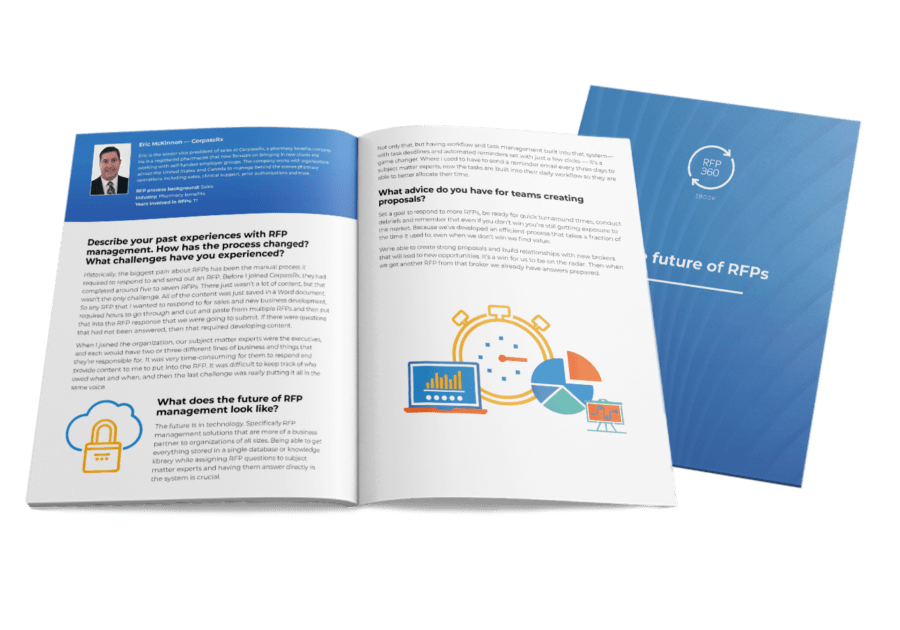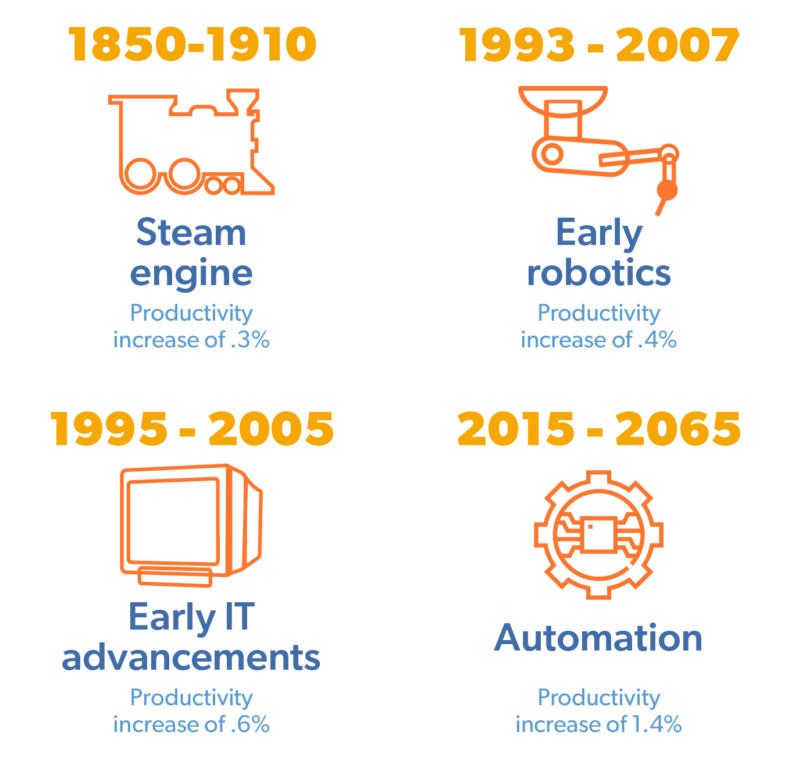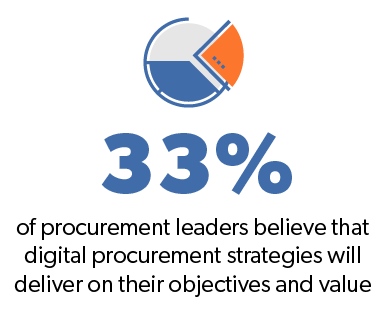Automation is everywhere. From paying bills to birthday reminders, the world is becoming increasingly automatic. Indeed, moving away from manually managing tedious and time-consuming tasks appeals to almost everyone. So, it’s no surprise that RFP automation is on the rise.
As technology advances, procurement teams benefit from improved efficiency, data insights and better vendor management driven by automation. This evolution reduces procurement costs by streamlining strategic sourcing — and it will make your life easier.
In this article, we’ll focus on buy-side procurement automation. Specifically, we’ll explore RFP automation. However, if you’re interested in learning about sell-side proposal automation, we have a post for that too: Proposal automation: Benefits, capabilities and how to prepare.
Here we’ll start with RFP automation basics and background. Then, I’ll share how technology works to make issuing RFPs faster and easier. Finally, we’ll dig into some automation myths that don’t ring true.
- The basics: What is RFP automation?
- Parts of the RFP process you can automate
- Top 3 benefits of automation
- Procurement automation myths
The basics: What is RFP automation?
RFP automation is the use of technology to complete the tasks required to create, manage and evaluate an RFP. Strategic sourcing software, sometimes called RFP management software, is the primary way that procurement teams deploy automation.
Automation has come a long way in the last decade. In fact, RFP software now leverages the latest advances in artificial intelligence (AI), machine learning and natural language processing to power automation. In light of the efficiency these tools deliver, it’s certain that technology will play a big part in the future of RFPs.
Explore expert insights and advice for procurement teams in the ebook: The future of RFPs.

A brief history of automation
Automation is at its best when it takes repetitive tasks that waste your time and do them for you. Once adopted, automation works in the background and frees your time to focus on other projects that add value to your organization. Indeed, both you and your company benefit from RFP automation.
A study by McKinsey estimates that by 2065, automation could increase overall productivity by up to 1.4 percent. It may not sound impressive, but to put it in context, it’s more than twice the productivity gained from early technology advancements.

The future outlook for procurement automation
A recent survey of chief procurement officers (CPOs) indicated that adoption of digital procurement tools, like automation, is growing. The study reported that 33 percent of procurement leaders believe technology will help deliver on their objectives and value.

Furthermore, the 2019 Deloitte CPO report discusses the value of procurement automation saying,
“Automation can help make life a little easier for procurement leaders. CPOs can turn to automation for tactical activities (e.g., tail spend purchasing, accounts payable processes) to enable a focus shift to strategic activities such as business partnering.”
As digital transformation continues to change the way we work, procurement leaders increasingly view automation tools as essential. These tools fulfill the need to optimize processes and dedicate staff time to high-value, strategic initiatives.
Beyond the value to the organization, RFP automation delivers benefits even at an individual level. Developing cutting-edge automation skills that shift how you spend your time increases your value to the organization. In addition to contributing to career advancement, as you reduce the hours you spend on necessary but tedious tasks, you free time to spend on projects that are more interesting and satisfying.
And, the technology to make it happen is within reach. Indeed, RFP automation is now more affordable, accessible and impactful than ever. Businesses that take advantage of RFP automation save time, reduce costs and improve outcomes.
Parts of the RFP process you can automate
Many steps in the RFP process are manual, repetitive and time-consuming. But what can you actually use RFP technology to automate? From reminders and notifications to project management and stakeholder collaboration, there is a wealth of automation opportunities. As a result, procurement professionals save precious time.
RFP automation capabilities
Stakeholder requirement gathering
Rather than manually sending emails to each stakeholder involved in the procurement project, gather stakeholder RFP requirements in one place. RFP software centralizes your initial research process and catalogs feedback for future reference.
Save dynamic RFx templates and questions
Stop searching for old RFPs to patch together using copy and paste. Store all of your RFx templates and questions to make creating new projects faster and easier. For example, you can create question groupings for boilerplate background information, data security questions, technical information and more. Or, you can save individual questions and categorize them based on the type of procurement, region, department and so on.
Create vendor profiles or RFIs
If you maintain a catalog of vendor profiles or onboard potential vendors using a request for information (RFI), RFP software enables vendors to update their information proactively. So, you have the latest vendor offerings when you need to send out a new RFP without having to search through your inbox for the info.
Issue RFPs and communicate with vendors
With the click of a button, you can select the right vendors for your RFP, include instructions, issue an RFP, share updates, amend your RFP and send follow up reminders — all without clogging your inbox.
Track vendor proposal progress
Want to know who is responding to your RFP? RFP software empowers you to just check a dashboard rather than manually inquiring with every vendor. With time, you’ll be able to use this information to optimize and shorten your RFP timeline.
Pricing table calculations
Proposal pricing is always a mess. For example, how do you compare software vendors who all offer pricing based on different factors? With pricing tables, the calculations are done for you so you can review an apples-to-apples comparison of your options.
Team proposal scoring
Engaging stakeholders and various departments in the RFP scoring process has historically been tedious. The steps are time consuming. To start, you must break down each proposal to the relevant sections and send them out to the correct individual scorers. Then, you have to collect and collate feedback. Finally, you spend time resolving questions, averaging scores and clarifying inconsistencies. Frankly, it’s a pain. However, with a few clicks, you can automate the process entirely and review the results with no extra effort.
Manage weighted scoring
Prioritizing your purchase considerations is simple with RFP automation. Just indicate the weights of questions and sections and the technology takes care of the rest. Weighted scoring calculations and visualizations are updated in real time and easy to understand.
These common RFP tasks, when done manually, may take a couple of minutes or hours each. However, using automation makes them almost instantaneous so you can move on to more important things.
Top 3 benefits of automation
Beyond simply making RFPs easier, automation has far-reaching benefits to the wider business.
1. Time savings and productivity
Time savings and productivity is where procurement managers most feel the impact of automation. Spending less time completing routine, mundane tasks lets you focus on other higher-value projects.
In addition to the RFP automation benefits noted above, if your procurement team also issues RFIs, RFQs, DDQs, security questionnaires or other requests, automation can be applied to these projects as well. The hours you save can then be spent tackling that list of projects that you never seem to have time for.
2. Consistency and compliance
Much of the inefficiency in the RFP process is traceable to a single core issue — siloed knowledge. Manually issuing RFPs often involves using countless emails, messages, calls and spreadsheets.
Siloed knowledge increases the risk of sending inaccurate RFPs, discouraging vendor participation and investing in the wrong solution. Solving this problem by centralizing knowledge is where RFP management tools really shine.
Improve consistency and compliance by removing the barriers to knowledge. RFP software offers a collaborative environment where your procurement team and RFP contributors can work together on RFP templates, requirements, questions and more.
3. Data capture and analytics
Many believe that data and analytics are the future of procurement. In fact, a report from Deloitte indicates that 54 percent of CPOs surveyed believe that analytics will have the highest impact on business in the next two years. Data gathered from automated processes allows businesses to quantify RFP software ROI. Moreover, data empowers cost optimization, process efficiency improvements and more.
For example, Piper Jordan, an employee benefits company, felt they were spending too much time on their RFP process.
“Our RFP process was very cumbersome. We had lots of text to review, and there was a great deal of manual intervention when it came to aggregating data. It just wasn’t the best use of our time.”
After implementing RFP automation they saw benefits almost immediately. Ultimately, they reported redirecting more than 40 hours per week to other work.
“When you think about overhead just in terms of aggregating and analyzing data … that’s a full-time job. So, we’re a lot more efficient now because the tool is automating that process.”
With automated processes in an RFP software platform, data is more easily captured and analyzed. If RFP data was more reliably and widely collected it could predict supply chain risks, track trends, better evaluate procurement costs and evaluate vendor performance. Truly, the insights could be endless.
Despite the benefits of RFP automation, there are some lingering misconceptions and myths that can make it seem scary, but it’s not — I promise. The best way to understand how to harness automation to the advantage of your to-do list is to learn more about it.
Procurement automation myths
1. Automation is going to take my job
RFP software is a tool, not a replacement for people — procurement and supply chain management are still very human. While RFP software can help issue and manage RFPs there are some things it can’t do. For instance, it can’t verify the accuracy of your RFP templates, interpret stakeholder requests or determine which vendor is the best fit. Even outside of the procurement process, McKinsey estimates that a very small number of jobs (less than five percent) could be automated entirely.
In fact, knowing how and when to leverage automation can make you an even more valuable employee. For instance, if you could spend less time managing manual tasks, you can spend more time maximizing the value of your current vendor partnerships.
2. RFP automation software is too expensive
The cloud-based, Software as a Service (SaaS) business model focuses on easy deployment and rapid return on investment (ROI). Typically SaaS RFP software is subscription-based. Therefore it must deliver value quickly to avoid churn.
Many procurement software solutions use a metric called time to value (TtV) to quantify the speed of adoption. TtV measures ROI and quantifies the time from a user’s initial engagement to reaching the ‘ah-ha’ moment. That moment is when the user realizes the value and possibility of the technology. Consequently, this quick-value imperative means that customers regularly enjoy new features, updates and enhancements. So, you always have access to the latest, greatest tools at a predictable price.
All this to say nothing of the burden of inefficiency. Delaying automation may actually cost your business more in the long-run. Unsurprisingly, employees who aren’t equipped with the right tools and are overloaded by work are 68 percent less productive.
3. Proposal automation software only does one thing
One of the great things about RFP management tools is that the technology can be used in a lot of different ways. The system can help you manage any document that uses a question and answer format. So, beyond automating RFx documents like RFIs, RFQs, RFBs; the technology also works well with security questionnaires, due diligence questionnaires and vendor profiles. Therefore, the value of RFP software may extend to many departments across the entire business.
Why automation matters
Businesses that take advantage of the benefits of automation empower employees to spend time on optimizing other areas. Accordingly, they are more strategic and enjoy better outcomes. A quote from the CPO survey summarizes why procurement and RFP automation as well as digital transformation matter, saying:
“Many of procurement’s value-creation priorities are dependent on digital capabilities, whether that be automation that allows resources to spend more time collaborating with suppliers (and tapping their digital capabilities) or utilizing analytics and third-party intelligence sources that can actually drive planning efforts rather than just reacting to them.”



